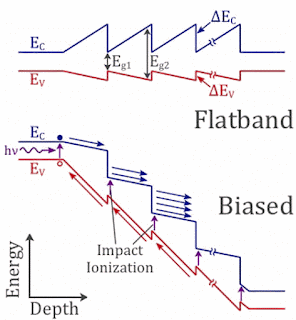 |
| Fig. 1 |
Conceptual band diagrams of a staircase APD unbiased (top) and under reverse bias (bottom). The arrows below the valance band indicate that holes do not impact ionize.
Citation: Appl. Phys. Lett. 108, 081101 (2016); http://dx.doi.org/10.1063/1.4942370
Topics: Electronics, Photonics, Semiconductor Technology, Quantum Mechanics
An avalanche photodiode is a semiconductor-based photodetector (photodiode) which is operated with a relatively high reverse voltage (typically tens or even hundreds of volts), sometimes just below breakdown. In this regime, carriers (electrons and holes) excited by absorbed photons are strongly accelerated in the strong internal electric field, so that they can generate secondary carriers, as it also occurs in photomultipliers. The avalanche process, which may take place over a distance of only a few micrometers, for example, effectively amplifies the photocurrent by a significant factor. Therefore, avalanche photodiodes can be used for very sensitive detectors, which need less electronic signal amplification and are thus less susceptible to electronic noise. However, the avalanche process itself is subject to quantum noise and amplification noise, which can offset the mentioned advantage. The excess noise is quantified with the excess noise factor F, which is the factor by which the electronic noise power is increased compared with that of an ideal photodetector. *
* Encyclopedia of Laser Physics and Technology: Avalanche Photodiodes
Abstract
Over 30 years ago, Capasso and co-workers [IEEE Trans. Electron Devices 30, 381 (1982)] proposed the staircase avalanche photodetector (APD) as a solid-state analog of the photomultiplier tube. In this structure, electron multiplication occurs deterministically at steps in the conduction band profile, which function as the dynodes of a photomultiplier tube, leading to low excess multiplication noise. Unlike traditional APDs, the origin of staircase gain is band engineering rather than large applied electric fields. Unfortunately, the materials available at the time, principally AlxGa1−xAs/GaAs, did not offer sufficiently large conduction band offsets and energy separations between the direct and indirect valleys to realize the full potential of the staircase gain mechanism. Here, we report a true staircase APD operation using alloys of a rather underexplored material,AlxIn1−xAsySb1−y, lattice-matched to GaSb. Single step “staircase” devices exhibited a constant gain of ∼2×, over a broad range of applied bias, operating temperature, and excitation wavelengths/intensities, consistent with Monte Carlo calculations.
Applied Physics Letters: AlInAsSb/GaSb staircase avalanche photodiode
Min Ren, Scott Maddox, Yaojia Chen1, Madison Woodson1, Joe C. Campbell1 and Seth Bank
Comments